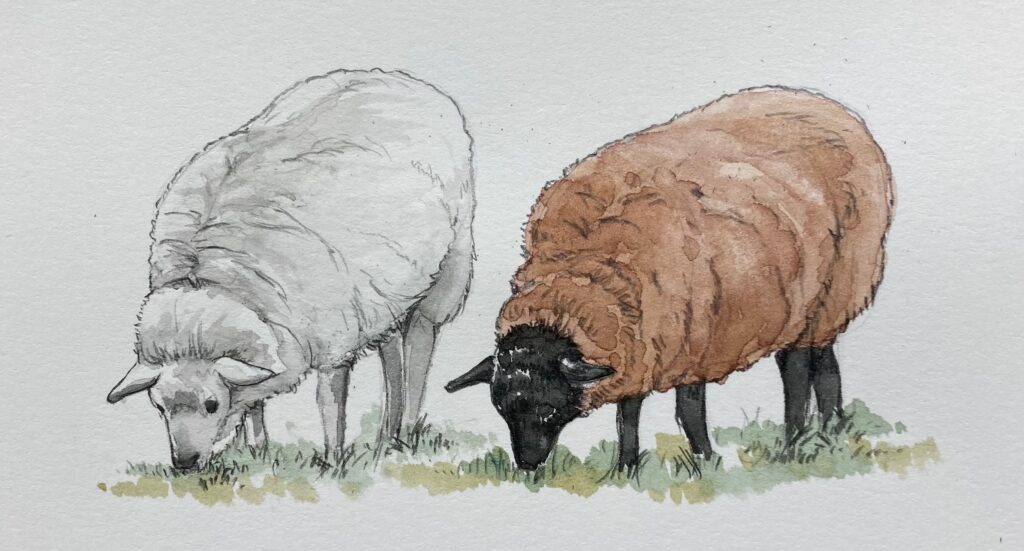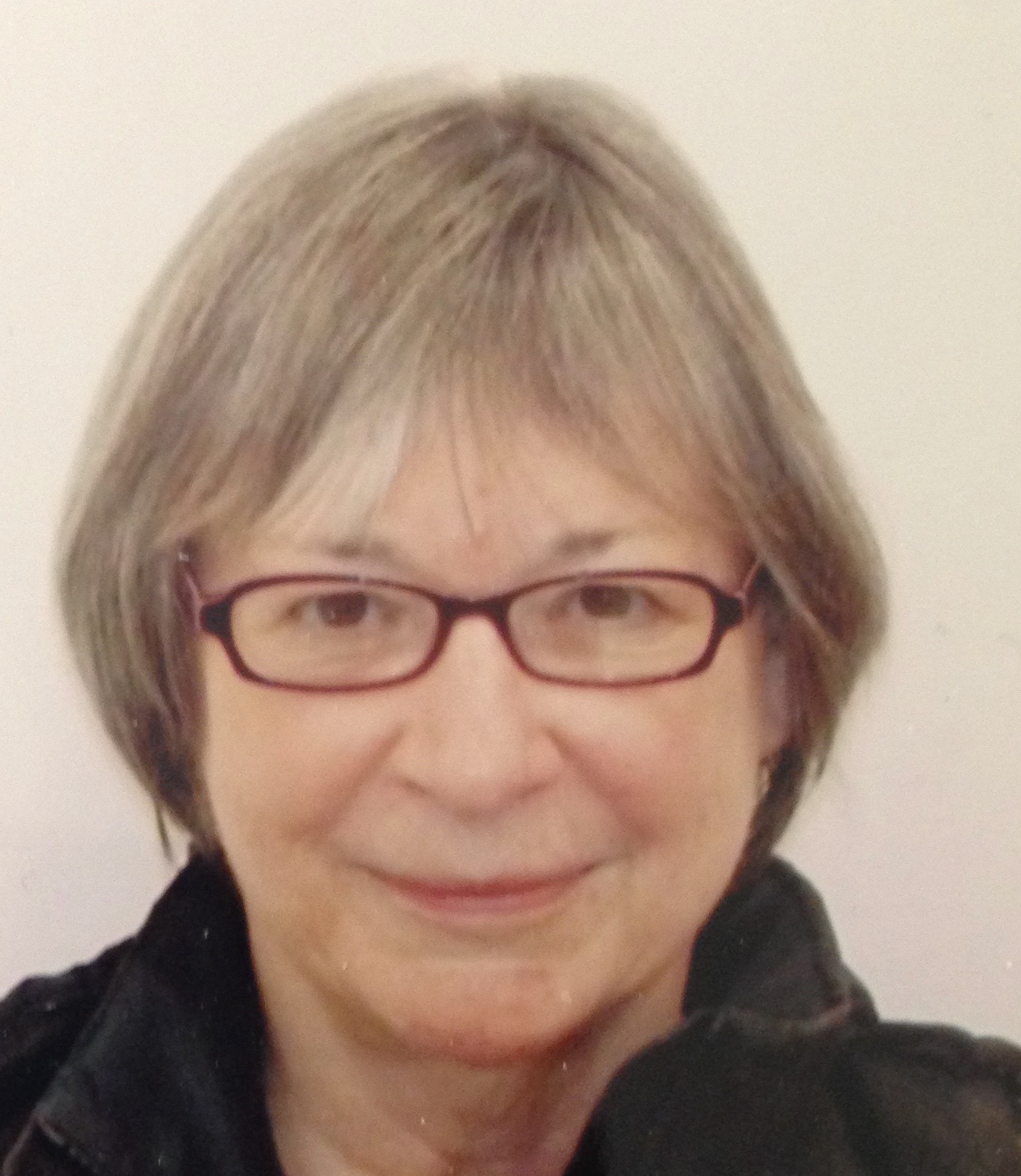By Susan M. Strawn
Late afternoon my second day in the Shetland Islands, I walked past the ferry terminal toward my hotel in Lerwick. I heard footsteps, quick and determined, following me.
My shoulders stiffened.
I tightened my grip on the shoulder strap of my backpack.
I have my knitting, I thought. At least I have sharp, pointed sticks with me.
I walked faster.
A man caught up with me.
“You here for the knitting?” he asked.
I kept my eyes to myself, with only a quick glance toward him. He was a middle-aged man in a knitted Shetland Fair Isle sweater vest. I nodded but squared my shoulders, looked straight ahead, and walked a little faster.
Back in the States, I lived in a condo in a Chicago suburb four blocks from the boundary of one of the most violent, gang-controlled neighborhoods in the city. I never drove with car doors unlocked or windows down, not even a little. Never. My Resident Beat Officer, the policeman assigned to live and work within my neighborhood, emailed crime alerts. Riding the El into the city, I learned to keep my eyes and ears – my naively curious eyes and ears – from wandering to other passengers. At the El stop near my home, I once saw the Guardian Angels, a volunteer safety patrol of men wearing signature red berets and jackets. The Angels brought a swift end to a scary high number of armed robberies plaguing the area.
The man in the Fair Isle vest fell into step beside me.
“What made you think I’m here for the knitting?” I asked. I wore nothing hand knitted. I carried my knitted sock-in-progress in my backpack, not a knitting bag.
“You just have the look,” he said and shrugged his Fair Isle shoulders. “My daughter told me about the knitting, the In the Loop conference for the knitters. She said knitters from all over are here in Shetland. Where are you from?”
“I’m here from Seattle,” I said. That was partly true. I lived in the Pacific Northwest during summers when I wasn’t teaching in Chicago. In the past, saying I was from Chicago raised too many eyebrows and questions about organized crime and racial tension, complex questions I could not answer, let alone understand.
“My daughter Kirsty’s a knitting designer,” he said. “Look for her tomorrow. She’ll be with the other designers showing her work at the Mareel Center.” I slowed my pace and smiled toward him. We walked together and chatted about Lerwick’s Fair Isle Festival, a weeklong celebration of traditional colorwork knitting, a specific kind of stranded knitting worked with only two colors in each row.
We reached my hotel. “Remember to look for Kirsty tomorrow,” he said. “She is very talented. I do love her so.”
Odd the way my fear had surfaced so quickly. I knew the Shetland Islands were a safe place, with violent crime rare. And the day before, my first day in Shetland had been as wholesome as a county fair in Iowa. A Norwegian friend also here for the knitting conference had invited me to drive with her to the Voe Show, an annual agricultural exhibition that popped up for only one day. The Voe Show promised sheep, wool, and knitting.
Our day at Voe had been sterling, the sky deeply and metallically clear. We drove the twenty miles north from Lerwick to Voe over hills that were rolling ocean waves of shrubby grassland, softly green and brown. No trees or shrubs. Clearance for firewood and grazing sheep did not mix well with tree growth. Here and there, whitewashed cottages nestled into the landscape. On clotheslines beside cottages, household linens and clothing flapped enthusiastically in the ceaseless North Atlantic wind. Random scatterings of glacial boulders dotted the landscape. In my imagination, I saw the hidden folk – trolls and elves of Scottish folklore – emerge after sunset and toss the boulders about, just for fun, then trudge down steep slopes to rocky North Sea beaches.
At the Voe Show, my friend and I roamed among outdoor pens with Shetland sheep, ponies, and cattle, sturdy creatures well adapted to Shetland’s cool maritime climate. Sheep fleece mingled shades of soft white and cream, brown, gray, some white with black spots. We leaned on fenced enclosures, inhaled the familiar earthy aromas, and chatted with herders 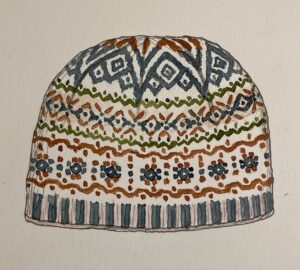 and farmers brushing the coats of their livestock for the show field. In one pen, tethered sheep dogs, their long fur starkly black and white, muscles like loaded springs, kept eyes trained on sheep.
and farmers brushing the coats of their livestock for the show field. In one pen, tethered sheep dogs, their long fur starkly black and white, muscles like loaded springs, kept eyes trained on sheep.
I headed for a large brick building with the sign that read, KNITTING. Inside, a display of knitting by peerie makkers (little knitters) had simple scarves and pillows, whimsical chicks, rabbits, a penguin, a mouse. Ribbon rosettes on each entry read, WELL DONE. I meandered deeper into rooms with Fair Isle jumpers (sweaters) and vests in countless color combinations. Hoodies with Fair Isle yokes. Fair Isle mittens, gloves, socks, bags, pillows. Clusters of Fair Isle keps (caps) and berets. Traditional haps – garter stitch shawls with lacy borders – and lace shawls and scarves, spidery fine and complex. The best received red (first place) or blue (second place) ribbons. How could judges decide among them?
Rarely had I coveted so many things at one time. Many pieces were for sale. I chose a white shawl with a Shetland cockleshell pattern.
“Actually, I wanted that black shawl with the same pattern, the one over there,” I told the volunteer who rang up my purchase. “But it’s already sold.”
“That’s one of mine,” she said. “I can knit you another one, if you’d like.” She smiled, her pleasant face, round and ruddy, framed with curly brown hair.
Just then, my Norwegian friend caught up with me, needing to return to Lerwick.
“I’m sorry,” the volunteer told me. “I can’t take down your shawl until the show closes, after 4:00.” She grimaced slightly, then smiled. “But I’m going into Lerwick tomorrow. Are you staying in Lerwick? I’ll bring you the shawl.”
Her name was Ella, she lived in the village of Voe, and the next morning we met at Mareel Center café near the Shetland Museum and Archives. Over coffee, we chatted about what we were knitting, as knitters do. I pulled out my travel knitting, a sock on four double-pointed needles. For me, socks were comfort knitting – the mac and cheese, chicken noodle soup of knitting – but for Ella, sock knitting was Shetland history. Women in nineteenth-century Shetland knit stockings (stockings are longer than socks) and bartered with visiting seafarers for food and household goods.
“I’ve been promising myself a trip to Jamieson’s in Sandness to buy yarn,” she said. “Today would be good. I’d love some company. Would you like to go?”
Jamieson’s of Shetland, a family-owned spinning and knitting mill for five generations, since 1893, specializes in wool from native Shetland sheep.
She may have mistaken my look of surprise as hesitation.
“There’s a shop,” she added. “And we could tour the mill.”
She made it sound like I was doing her a favor. I had no hesitation.
Sandness, a district and a scattered community, lies in the far northwestern corner of mainland Shetland. The further we drove from Lerwick into open countryside, the more Shetland sheep I saw roaming freely on the land, and the more sheep with natural color fleece – gray, brown, black – instead of white.
“This is so different,” I said.
“In the States, you drive a bigger car than mine, don’t you?” she asked.
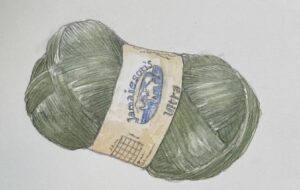 “It isn’t that,” I said. “It’s the animals on the land. I’m thinking about my years living in Iowa. I could drive a hundred miles and not see a cow or sheep or hog on the land. Except in Amish country.” Ella slowed to let two fluffy, reddish-brown sheep – a color known locally as moorit – stroll across the roadway on their spindly legs. In the distance, sheep grazed beside stone walls that ran across low hills with whitewashed croft cottages.
“It isn’t that,” I said. “It’s the animals on the land. I’m thinking about my years living in Iowa. I could drive a hundred miles and not see a cow or sheep or hog on the land. Except in Amish country.” Ella slowed to let two fluffy, reddish-brown sheep – a color known locally as moorit – stroll across the roadway on their spindly legs. In the distance, sheep grazed beside stone walls that ran across low hills with whitewashed croft cottages.
“On American farms, the animals – chickens, turkeys, hogs, whatever – are crowded indoors, out of view, inside long sheds. Cattle are packed into holding pens,” I said. “There’s more profit that way, more productivity. Factory farming, I’ve heard it called.” I told her about federal subsidies that paid farmers to raise corn, beans, and hogs, mostly, about the way that price supports for sheep and wool had plummeted over time, dragging down the price of wool. Farmers could no longer afford to raise sheep for commercial wool.
“Don’t knitters want to buy yarn from sheep raised in America?” Ella asked.
“Oh, yes,” I said. “I know spinners and knitters who care about the sheep, about the source of their wool. For one thing, they love to work with natural colors from different breeds.” Sheep had been bred for white fleece, favored for commercial dyeing. I told her about local producers who keep small flocks like Navajo-Churro or Shetland or Lincoln Longwools, among others, and about a yarn shop owner who buys local Corriedale fleece and has it spun into her signature knitting yarn.
“Spinners like to learn how to spin fleece from different breeds, figure out which breed is right for different products. They go to spinning and knitting workshops and fiber festivals from Maryland to California and everywhere in between. I don’t spin, but I’m fascinated by their enthusiasm.” There were several new books, in-depth and well-researched, about working with fiber and fleece from different breeds, especially endangered and rare breeds. I told her I believed the handcraft market was a chance to save the sheep from the monoculture of mainstream agriculture.
Ella slowed her car for a cluster of sheep chomping their way along the side of the road. Shetland sheep grazing freely on the land, we agreed, was a sight to savor.
We drove further on the winding road over moorland studded with lochs. Jamieson’s mill was a nondescript brick building perched high above the sea over St. Magnus Bay with a view of the island of Papa Stour. Inside, the factory manager told us no one was available for a tour of the mill. Most employees were on summer holiday.
“Could we maybe walk around on our own?” I asked, hoping my American accent hinted that I had traveled a long way for this.
“All right,” he said. “Go ahead and walk around. Just don’t put your hands into anything that’s moving.” He strode back to his office and left us on our own.
I was not in the States anymore.
How odd to explore freely, up-close to the scouring, carding, mixing, spinning machines, ball winders that turned Shetland raw fleece into finished yarn and knitwear. A skeleton crew kept some machines running, each a loud and forceful presence. In the knitting studio, jumpers, turned out one at a time, dangled limply from industrial knitting machines. In the factory sales shop, I pulled back a curtain to find a wall of Jamieson’s Shetland yarn – they have 220 colors in all – from lace weight to two-ply to chunky. The yarn held the loft, the resilience, the comforting warmth of sheep on the Shetland landscape.
Ella reached around me and pulled skeins of coral, orange, green, turquoise blue. She saw my look of surprise. “I need bright colors for the winter,” she said. “On the shortest day, there’s only six hours of sun.”
“I want to remember the colors I saw on our drive today,” I told her. I gathered into my arms balls of two-ply yarn in earthy greens and browns and blues and grays, the natural and dyed colors of the land and sheep, the sea, the clouds, the sky. I would knit Fair Isle keps, a scarf, perhaps a blanket with colors that would bring back to mind the Shetland landscape.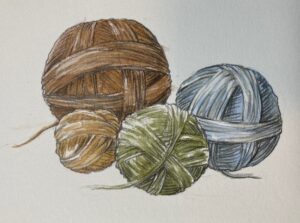
Ella and I said our good-byes and thanks in Lerwick. The seventeenth-century Hanseatic burgh was all decked out for its Fair Isle Festival, and I wandered, comfortable and secure, among the clusters and occasional crowds in the shopping streets. Overhead, ropes of Fair Isle bunting crisscrossed narrow passageways between buildings of weathered stone. Fair Isle knitting filled every shop window. An appliance store pinned jumpers onto a clothesline behind tumble dryers. The library and bookshops rolled out knitting pattern books and postcards. I bought postcards of two Shetland ponies looking nonchalant in their knitted Fair Isle jumpers. Knitting shops offered bins of Shetland yarn, clothing stores sold jumpers and caps. A charity shop sold hand-knitted “Royal Babies,” wee souvenirs commemorating the birth of Prince George.
Past the shopping district, I walked alone on the street toward my hotel. And then I heard those footsteps behind me. I felt a stab of sadness to find myself suddenly fearful, vulnerable, on alert on alert at the sound of footsteps following me. I had carried that fear with me for four thousand miles and 24 hours of travel – two airline flights and an overnight ferry – from the place where I always watched my back.
My fear vanished into the clear air of Shetland when the stranger who fell into step beside me asked if I were there for the knitting. All my life, knitting had offered a safe port in the storms of adolescence and the missteps or traumas of life. Knitting had been a safe way to soften the search for new friends each time I took up residence in a new city.
My time in the Shetland Islands was free of danger, real or imagined.
There was no conflict and drama, no turning point in my life.
Among the knitters, I simply belonged.
Belonging meant safety.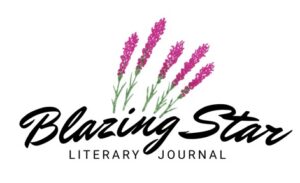
And that was enough.
Illustrations by Susan M. Strawn
Copyright © 2023 by Susan M. Strawn
Susan M. Strawn
Knitting: a faithful, lifelong companion
Susan M. Strawn, Ph.D.
The Shetland Fair Isle Kep is a chapter from Susan’s new memoir in progress, Loopy: Stories from a Knitting Life.
Susan has been a knitter and loved making cloth and clothing since childhood.
She is the author of Knitting America: A Glorious History from Warm Socks to High Art (Voyageur Press, 2007), a cultural history of knitting and recipient of a first-place award from Midwest Independent Book Publishers. She has researched and written more than 50 trade and juried publications, many on the history of American knitting, and has delivered numerous professional presentations. She serves as contributing editor to PieceWork, a magazine of history and needlework.
Susan’s immersion in extraordinary hand-crafted textiles while staff artist at Interweave Press inspired her to return for graduate studies in historic and cultural textiles. Her doctoral dissertation examined the restoration of Navajo Churro sheep and wool to Navajo weavers. As a tenured professor of Fashion Design and Merchandising at Dominican University (Chicago), she taught historical and cultural dress, textile science, and surface design of fabric. In 2015, she stepped down from teaching as professor emerita.
Susan continues to find and write stories otherwise hidden in cloth and clothing, with a particular interest in the history of knitting. She lives on Bainbridge Island, Washington.
